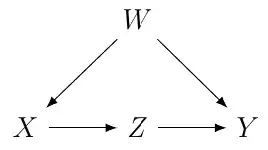Pearl et al. "Causal Inference in Statistics: A Primer" (2016) p. 39 states the following:
Rule 1 (Conditional Independence in Chains) Two variables, $X$ and $Y$, are conditionally independent given $Z$, if there is only one unidirectional path between $X$ and $Y$ and $Z$ is any set of variables that intercepts that path.
(And then notes that the rule only holds if the error terms associated with the variables are independent of each other.)
As a non-native speaker, I am not entirely sure I understand the rule correctly. Does the if clause say that
- there can only be one path AND
- that path must be unidirectional?
Or does it say that
- there can be many paths, but
- among them only a single one is unidirectional?
Or ...? (My understanding of the English punctuation suggests the second alternative, but my understanding of the context points to the first one.)
